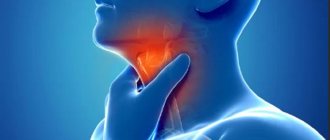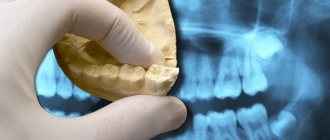- Etiology and pathogenesis
- Classification of tonsillitis Clinical forms of vulgar tonsillitis
- Treatment of vulgar tonsillitis.
As a disease of the pharynx, sore throat has been known since ancient times.
Sore throat is described in the works of Hippocrates (IV–V century BC), Celsus (I century AD), and also in the manuscripts of the Tajik physician Abu Ali Ibn Sina (Avicenna, 11th century) mention of intubation and tracheotomy for asphyxia due to tonsillitis, etc. Sore throat is a common acute infectious disease in which local inflammation affects the lymphadenoid tissue of various tonsils of the pharynx. In the vast majority of cases, tonsillitis occurs in the palatine tonsils, while other tonsils are involved in the process much less frequently. Angina is not a homogeneous disease; it differs in etiology, pathogenesis and form of clinical course.
Etiology and pathogenesis
Among the various possible microbial pathogens of sore throat (cocci, bacilli, viruses, spirochetes, fungi, etc.), in most cases the main etiological role belongs to group A b-hemolytic streptococcus (GABHS). This pathogen, according to a number of authors, is detected in sore throat in more than 80%, according to other sources - in 50–70% of cases. Much less frequently, acute tonsillitis is caused by group C and G streptococci, Arcanobacterium haemolyticum, Neisseria gonorrhoeae, Corynebacterium diphtheria (diphtheria), anaerobes and spirochetes (Simanovsky-Plaut-Vincent angina), and extremely rarely by mycoplasma and chlamydia. The cause of acute viral tonsillitis can be adenovirus, rhinovirus, coronavirus, influenza and parainfluenza viruses, Epstein-Barr virus, Coxsackie A virus and others. Penetration of an exogenous pathogen into the mucous membrane of the tonsils can occur through airborne droplets and alimentary routes, as well as through direct contact. In the occurrence of an endogenous pathogen, great importance is attached to chronic tonsillitis. As noted by B.S. Preob¬ra¬zhensky (1954), the frequency of sore throats in chronic tonsillitis is explained by the fact that in this disease there are usually up to 75% of cases of carriage of GABHS, vegetating in the crypts of the palatine tonsils.
In the pathogenesis of tonsillitis, a certain role can be played by a decrease in the body’s overall reactivity to cold, sharp seasonal fluctuations in environmental conditions (temperature, humidity, nutrition, intake of vitamins, etc.), trauma to the tonsils, constitutional predisposition to tonsillitis (for example, in children with lymphatic – hyperplastic constitution), the state of the central and autonomic nervous system. Factors predisposing to angina are chronic inflammatory processes in the mouth, nose and paranasal sinuses. The development of sore throat occurs according to the type of allergic-hyperergic reaction, which is a prerequisite for complications such as rheumatism, acute diffuse nephritis and other diseases of an infectious-allergic nature and associated with the GABHS antigen.
Causes
The most typical infectious agents include staphylococci, streptococci, pneumococci, some representatives of the diplococcus genus and enteroviruses.
Routes of infection:
- Endogenous (in patients suffering from gastroenteritis, purulent sinusitis, chronic tonsillitis and caries).
- Airborne (the most typical route of transmission).
- Enteral (together with contaminated dairy products).
- Hematogenous (with blood flow from organs and tissues infected with the pathogen).
- Artificial (during surgical operations on the nasopharynx and nasal cavity).
Most often, angina affects people who have reduced sensitization and reactivity of the body, or have congenital immaturity of physiological systems, or have chronic pathological processes in the ENT organs. At the same time, the condition of the tonsils and the virulence of the microflora play an important role in the development of the disease.
Classification of sore throats
In practice, the classification of B.S. is most widespread. Preobrazhensky, based on pharyngoscopic signs, supplemented by data obtained during laboratory research, sometimes with information of an etiological or pathogenetic nature.
This classification includes the following forms of sore throat: I - catarrhal, II - follicular, III - lacunar, IV - fibrinous, V - herpetic, VI - phlegmonous (intratonsillar abscess), VII - ulcerative-necrotic (ganrenous), VIII - mixed forms.
To this main diagnosis, after obtaining the appropriate data, the name of the microbe that caused the sore throat (streptococcal, staphylococcal, etc.) or other characteristic features (traumatic, toxic, monocytic, etc.) can be added.
It is customary among clinicians to divide all existing sore throats into vulgar (or banal) and atypical.
Vulgar tonsillitis is characterized by the presence of four general signs: (1) there are severe symptoms of general intoxication of the body; (2) there are pathological changes in both tonsils; (3) the duration of vulgar sore throat does not exceed 7 days (1 week); (4) the primary factor in the etiology of these sore throats is a bacterial or viral infection.
Clinical forms of vulgar tonsillitis
Among a large group of sore throats, the most common are vulgar (ordinary, banal) sore throats, which arise in connection with the introduction of one or another microbial or viral infection. These sore throats are recognized mainly by pharyngoscopic signs. These include catarrhal, lacunar, follicular, fibrinous and phlegmonous (intratonsillar abscess). The most common forms are:
Catarrhal sore throat.
The disease begins acutely, with burning sensations, dryness, soreness in the throat, and then slight pain when swallowing. I am concerned about general malaise, weakness, headache. Body temperature is usually low-grade; There are slight inflammatory changes in the peripheral blood. Faringoscopically, diffuse hyperemia of the tonsils and the edges of the palatine arches is determined; the tonsils are somewhat swollen. The tongue is dry and coated. There is often a slight enlargement of regional lymph nodes. In rare cases, catarrhal tonsillitis is more severe. In childhood, clinical phenomena are more pronounced than in adults. Usually the illness lasts 3–5 days.
Follicular tonsillitis.
It is characterized by predominant damage to the parenchyma of the tonsils and their follicular apparatus. Like lacunar, follicular tonsillitis begins with sudden chills with an increase in body temperature to 40°C, severe sore throat. The phenomena of intoxication are pronounced. Patients are concerned about severe general weakness, headache, pain in the heart, joints and muscles. Sometimes dyspepsia and oliguria are observed. The palatine tonsils are hyperemic and sharply swollen. Follicles in the form of whitish-yellowish formations the size of a pinhead are visible through the epithelial cover. The surface of the tonsil, in the figurative expression of N.P. Simanovsky, takes on the appearance of a “starry sky”. Regional lymphadenitis is pronounced.
Lacunar tonsillitis.
The onset of the disease and its general symptoms are the same as with follicular tonsillitis. More often, lacunar tonsillitis is more severe than follicular tonsillitis. The pharyngoscopic picture in lacunar angina is characterized by the appearance on the hyperemic surface of enlarged tonsils, first limited at the mouths of the lacunae, and then more and more widely covering the tonsil of islands of yellowish-white plaque. Sometimes individual areas of plaque merge and cover a larger or smaller part of the tonsil, without going beyond its limits. Plaque is easily removed without damaging the epithelial layer. During the period of plaque separation, on days 2–5, the severity of symptoms most often decreases, but the temperature usually remains low-grade until the inflammatory reaction in the regional lymph nodes subsides. The duration of the disease is 5–7 days; in case of complications, it can be delayed for a longer period.
In addition to the palatine tonsils, acute inflammation may also involve other accumulations of lymphadenoid tissue, in particular those located in the nasopharynx (retronasal tonsillitis - adenoiditis, tubular tonsillitis), at the root of the tongue (lingual tonsillitis or tonsillitis IV of the tonsil). Sometimes the inflammation is diffuse, spreading throughout the lymphadenoid pharyngeal ring.
Acute inflammation of the pharyngeal tonsil (adenoiditis) is characterized by: sore throat, radiating to the deep parts of the nose, difficulty nasal breathing. The disease occurs mainly in pediatric practice.
Damage to the lingual tonsil is accompanied by pain when swallowing and when protruding the tongue. Inflammation, spreading to connective and intermuscular tissue, can lead to interstitial purulent inflammation of the tongue.
Kinds
Based on the nature of structural changes and involvement of the palatine tonsils in the process, the following types of sore throats are distinguished:
- catarrhal - without pus, the mildest form;
- follicular - with the formation of pus;
- lacunar - also a purulent form of tonsillitis;
Depending on the pathogen that caused the infectious process in the tonsils, tonsillitis can be streptococcal, staphylococcal, or mixed etiology.
According to the course of the disease, angina can be mild, moderate and severe.
Complications of sore throat
Patients with angina may experience the following local complications: peritonsillitis and peritonsillar abscess, otitis media, etc. They usually occur in people whose treatment was started relatively late - after the 3rd day from the moment of illness. Peritonsillitis and paratonsillar abscess have similar symptoms, which include: high fever, predominance of unilateral pain in the oropharynx, sharply intensifying when swallowing, increased salivation, trismus and pain when opening the mouth, unilateral edema, hyperemia of the soft palate, swelling of the palatine arch on the affected side, and also a shift to the center of the affected tonsil and asymmetry of the uvula.
In addition to local complications, angina can cause metatonsillar diseases - rheumatism, infectious-allergic myocarditis and polyarthritis, cholecystocholangitis. With modern approaches to the treatment of patients with tonsillitis, rheumatism and polyarthritis, it is more often possible to avoid other metatonsillar diseases (for example, glomerulonephritis in 0.8% with primary tonsillitis and in 3.0% with a recurrent form of the disease).
Myocarditis develops with primary angina in the first days of the convalescence period, and with repeated angina - from the first days of the disease. This complication rarely manifests itself with the classic symptoms of this disease. Most often, the only signs of myocarditis are persistent changes in the electrocardiogram, indicating focal damage to the heart muscle, and a moderate increase in the 1st-2nd fractions of lactate dehydrogenase.
The development of glomerulonephritis corresponds to the time of formation of autoimmune (against kidney tissue) and immunopathological factors on the 5–6th day of normal body temperature (8–10th day of the disease). Glomerulonephritis occurs without extrarenal symptoms. Its only manifestation is persistent urinary syndrome in the form of moderate proteinuria (0.033–0.099 g/l), leukocyturia (10–50 cells per field of view in a urine sediment specimen), erythrocyturia (3–20 cells per field of view) and cylindruria .
What compresses are not prohibited?
Not all compresses are contraindicated for sore throat in a child. So, doctors allow those that do not warm a sore throat too much, for example, from:
- Cabbage leaves, which are good for relieving inflammation. You need to apply several leaves to the throat, wrap them with cellophane and a scarf on top. Leave overnight.
- Boiled potatoes. You need to crush it and wait until it becomes warm. Then apply it not to the throat, but to the neck. Cover the top with gauze and secure with cling film. Keep until cool.
- Cottage cheese. You need to put about 400-500 grams of cottage cheese at room temperature on cling film, put it on your neck, and wrap it with a cloth. Remove when the curd is completely dry. It is advisable to leave this compress overnight.
Treatment of sore throats
Treatment of vulgar tonsillitis.
The rational treatment of sore throats is based on adherence to a certain gentle regimen, local and general therapy. Bed rest is mandatory in the first days of the disease, and then at home without physical activity. Prescribe a non-irritating, soft, nutritious diet, mainly vegetable and dairy, vitamins, and drinking plenty of fluids is beneficial.
Patients with angina, regardless of the severity of the condition and the period of the disease (even after the fever subsides), require antibacterial treatment to prevent the subsequent development of the described metatonsillar diseases.
GABHS are highly sensitive to penicillins and cephalosporins. β-lactams remain the only class of antibiotics to which GABHS has not developed resistance. The main problem is resistance to macrolides, which in Russia is 13–17%. At the same time, the M-resistance phenotype, characterized by resistance to macrolides and sensitivity to lincosamides (lincomycin and clindamycin), has become widespread. Resistance to tetracyclines and sulfonamides of GABHS in Russia exceeds 60%. In addition, tetracyclines, sulfonamides, co-trimoxazole do not provide eradication of the pathogen, and therefore they should not be used for the treatment of acute streptococcal tonsillitis caused even by strains sensitive to them in vitro.
Given the high sensitivity of GABHS to b-lactams, the first-line (drug of choice) for the treatment of acute streptococcal tonsillitis is penicillin (phenoxymethylpenicillin). More reliable, due to the possible resistance of the pathogen, is the use of amoxicillin clavulanate and sulbactam. Oral cephalosporins are rarely used. In patients allergic to b-lactams, macrolides or lincosamides should be used. Recommended medications, doses and dosage regimens are presented below.
Antibacterial therapy for acute streptococcal tonsillitis
Penicillins
- amoxicillin 750 mg in 3 doses 10
- amoxicillin/clavulanate 625 mg in 3 divided doses 10
- amoxicillin/sulbactam
Cephalosporins
- Cefadroxil 30 mg/kg in 1 dose 10
Macrolides (prescribed
for β-lactam intolerance)
- azithromycin 12 mg/kg in 1 dose 5
- Clarithromycin 15 mg/kg in 2 divided doses 10
- midecamycin 50 mg/kg in 2 divided doses 10
- roxithromycin 5 mg/kg in 2 divided doses 10
- spiramycin 3 million units in 2 doses 10
Lincosamides (prescribed
with intolerance to β-lactams and macrolides)
- lincomycin 30 mg/kg in 3 doses 10
- clindamycin 20 mg/kg in 3 divided doses 10
In severe cases of the disease, the patient is treated in an infectious diseases hospital. Here it is rational to use parenteral administration of an antibiotic. To prevent candidiasis on an individual basis, it is necessary to prescribe antifungal drugs. It is also advisable to prescribe a hyposensitizing drug (diphenhydramine, chloropyramine, mebhydrolin, loratadine, etc.).
In addition to general therapy, rinsing (slightly warm) with a solution of furacillin, miramistin, calendula tincture, and chamomile decoction is prescribed locally; apply a warm compress to the submandibular area. During febrile periods, drinking plenty of fluids is recommended.
Antipyretics (paracetamol-containing: paracetamol, ketaprofen, ibuprofen, etc.) are indicated at a body temperature of 38°C and above.
In the acute period of the disease and in the first days of normal body temperature, bed rest is necessary, then semi-bed rest and home rest (until the 7th day of normal body temperature). At this time, taking multivitamins is indicated.
Health indicators after a sore throat are normal body temperature for 5 days, absence of sore throat and pain on palpation of the maxillary lymph nodes, normal blood tests, urine tests and electrocardiogram.
- Atypical tonsillitis should first of all include Simanovsky-Versan tonsillitis (ulcerative-necrotic), as well as tonsillitis that occurs with systemic blood diseases and leukemia, herpetic and fungal tonsillitis.
- Treatment of ulcerative-necrotic sore throat of Simanovsky-Vincent (symbiosis of the spindle-shaped rod (B. fusiformis) and spirochete (Spirochaeta buccalis) of the oral cavity) is carried out by an otolaryngologist and consists of lubricating the ulcerated mucous membrane of the pharynx with a 10% solution of novarsenol in glycerin , 2% solution of methylene blue, 1% solution of boric acid, 10% solution of copper sulfate. Gargling with a 0.1% solution of ethacridine lactate, 0.1% solution of potassium permanganate. In severe cases of the disease, amoxicillin clavulanate (625 mg x 3 times) and intravenous infusion of novarsenol (0.3–0.4 g at intervals of 1–2 days) are recommended.
- Treatment of patients suffering from secondary acute tonsillitis due to infectious diseases is carried out in an infectious diseases hospital. Etiotropic and pathogenetic therapy is used. Disinfecting rinses are used locally.
- Treatment of patients with secondary acute tonsillitis due to diseases of the blood system is carried out in a therapeutic or specialized hematology department according to the rules for the treatment of the underlying disease.
- Fungal tonsillitis (pharyngomycosis) occurs mainly in young children and is caused by yeast-like fungi of the genus Candida albicans in 95% and Leptotryx buccalis in 5%.
Treatment of mycotic tonsillitis should be comprehensive. It includes oral use of antifungal antibiotics for 10–14 days (levorin, nystatin, decalinium chloride, mycoheptin, amphoglucamine B, ketoconazole, fluconazole), ascorbic acid, antihistamines and B vitamins. Rinses and inhalations are prescribed locally. For inhalation use amphotericin B, sodium salt of levorin, fluconazole, for rinsing - an aqueous solution of 3% boric acid, gramicidin 1:10000, potassium permanganate 1:10000, 1% quinosol.
Folk remedies
Traditional medicine offers a large number of recipes for treating such a complex disease as sore throat at home. In case of acute tonsillitis, it is necessary to wash away microbes from the mucous membrane of the pharynx, and for this purpose it is recommended to use infusions and decoctions of herbs.
The following procedures give a good effect:
- Frequently rinsing the mouth with a solution of sea water helps get rid of pain in the throat.
- You can get rid of the unpleasant symptoms of the disease in a few days with the help of garlic, using it for compresses, inhalations and rinses.
- Drinking oregano decoction throughout the day will help get rid of hoarseness.
- at the very beginning of the development of tonsillitis, it is recommended to chew lemon zest along with the pulp and gargle with a solution of lemon juice.
- If a sore throat is accompanied by an increase in body temperature and chills, then warm tea with the addition of lingonberries, lemon or raspberries helps to alleviate the condition.
When diagnosing acute tonsillitis, it is important to drink as much fluid as possible, which will help remove all accumulated toxins from the body and restore water balance.
Prevention of sore throat
In addition to general restorative therapy and measures aimed at preventing infection, preparations of bacterial origin, in particular complexes of antigens - lysates, the most common causative agents of inflammatory diseases of the upper respiratory tract, oral cavity and pharynx, have proven to be an effective means of preventing exacerbations in various forms of pharyngitis and recurrent tonsillitis. It is possible to use similar drugs with systemic action, but this group of drugs has a greater number of contraindications.
It should be noted that all patients suffering from chronic tonsillitis who have had more than 2 sore throats over the past 3 years are subject to mandatory follow-up in group D3, that is, 2 times a year.
What to gargle with?
Local treatment of tonsillitis is no less effective than taking general medications. Gargling with solutions (furacilin, eludril, soda + iodine + salt), and decoctions (sage, calendula) helps eliminate pain and relieve inflammation of the tonsils.
You should gargle at least once every 2 hours; this process cleanses the pharyngeal mucosa from waste products of pathogenic microorganisms, washes away pus from its surface, and fights inflammation.
You can also watch a video of the program “Live Healthy” about the treatment of sore throat.









